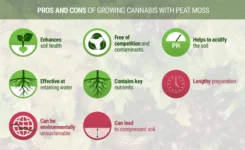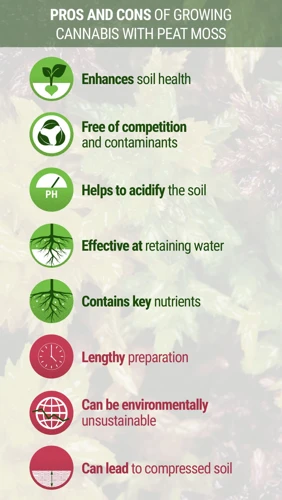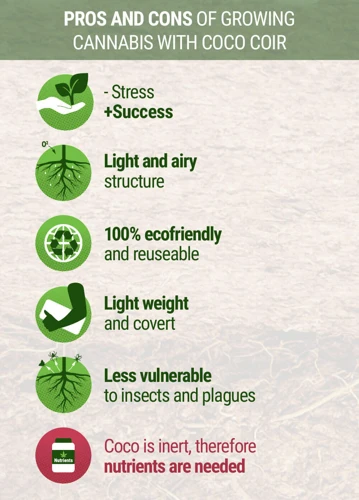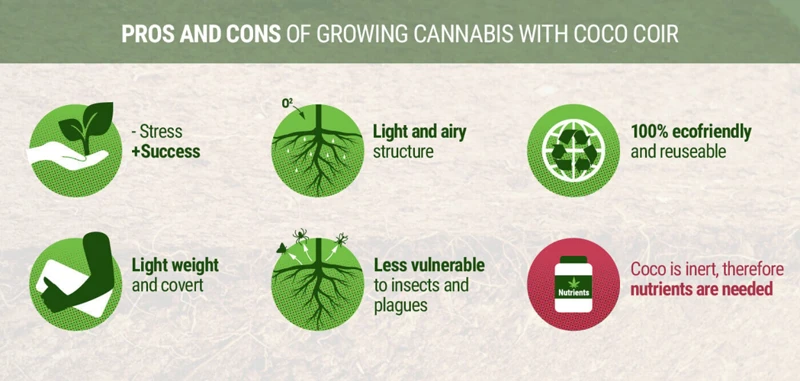
Is Coco Coir a Good Choice for Growing Cannabis?
Growing cannabis requires careful consideration of the medium in which the plants will be grown. One option that has gained popularity among growers is coco coir, a fiber extracted from the outer husk of coconuts. While coco coir offers several advantages, it also has its drawbacks. In this article, we will explore the advantages and disadvantages of using coco coir for growing cannabis, as well as provide some tips on how to effectively use this growing medium for optimal plant growth.
Advantages of Coco Coir for Growing Cannabis
Contents
When it comes to growing cannabis, choosing the right growing medium is crucial. Coco coir, a natural and renewable resource made from the husks of coconuts, has gained popularity as a growing medium in recent years. This versatile substrate offers numerous advantages that make it an attractive choice for cannabis growers. From its moisture-retaining properties to its environmentally friendly nature, coco coir has a lot to offer. Let’s take a closer look at the benefits of using coco coir for growing cannabis.
1. Retains Moisture
Coco coir has the ability to retain moisture, which is a crucial characteristic for any growing medium. This means that the coco coir can hold onto water and nutrients for longer periods of time, ensuring that the roots of the cannabis plants have access to a steady supply of hydration and nutrients. This can ultimately lead to healthier plants with more substantial yields.
Advantages of coco coir’s moisture retention:
- Coco coir helps to reduce the frequency of watering as it retains moisture for long periods of time.
- The ability to retain moisture makes coco coir a helpful medium in areas with low humidity, where it is difficult to keep the soil moist for long periods.
- Coco coir’s moisture retention also means that the plants will have a constant supply of water and nutrients, leading to healthier plants and potentially larger yields.
However, it is important to note that while coco coir has this advantageous characteristic, it is also easy to over-water plants in coco coir. It is crucial to monitor the moisture levels and avoid over-saturating the coco coir, as this can lead to issues such as root rot.
2. Good Drainage
One of the major advantages of using coco coir as a growing medium for cannabis is its excellent drainage capabilities. Good drainage is crucial for the health and growth of cannabis plants, as it helps to prevent waterlogged roots and fungal growth.
When it comes to coco coir, its natural fibrous structure and high lignin content allow for optimal drainage. In fact, coco coir can retain up to 10 times its weight in water while still providing adequate drainage for plant roots. This is because coco coir has the ability to hold onto moisture without becoming waterlogged.
This leads to several benefits:
- Less chance of overwatering – Coco coir’s excellent drainage helps prevent overwatering, which can lead to root rot and other plant diseases. This means that growers can water their plants less frequently, which can save time and resources.
- Better nutrient uptake – Because coco coir allows for good drainage, excess nutrients are flushed out of the growing medium rather than being absorbed by the plants. This helps prevent nutrient build-up and allows cannabis plants to more effectively absorb the nutrients they need for healthy growth.
- Improved oxygen levels – Good drainage ensures that the roots of cannabis plants have access to adequate oxygen levels, which is essential for healthy root development.
The good drainage capabilities of coco coir make it an excellent choice for cannabis growers who want to ensure their plants are healthy and thriving. However, it’s important to note that using coco coir alone may not provide enough nutrients for cannabis plants to grow properly, and growers may need to supplement with additional nutrients.
3. Renewable Resource
Coco coir is an eco-friendly growing medium because it is a renewable resource. It is made from the fibrous material found between the hard, internal shell and the outer coat of a coconut. This material is typically discarded as waste, so using it as a growing medium helps to reduce waste and promote sustainability.
Coconuts are plentiful in tropical regions, making it a locally-sourced and sustainable option. Using coco coir for growing cannabis also reduces the demand for peat moss, which is often harvested from non-renewable peat bogs.
Additionally, coco coir can be reused for several growing cycles. After the first use, it can be rinsed and sterilized, allowing it to be used again. This not only reduces waste but also makes coco coir a cost-effective growing medium in the long run.
Furthermore, coco coir is biodegradable, which means it can be composted after it has served its purpose as a growing medium. This helps to close the loop on waste and reduce the environmental impact of cannabis cultivation.
In conclusion, using coco coir for growing cannabis is a renewable and sustainable option that reduces waste and promotes environmental responsibility. By choosing a growing medium that is eco-friendly, cannabis cultivators can do their part in creating a more sustainable future.
Disadvantages of Coco Coir for Growing Cannabis
While there are many advantages to using coco coir as a growing medium for cannabis, it is important to also consider some of the potential drawbacks. Coco coir, like any other growing medium or substrate, has its own set of limitations and challenges that growers must be prepared to address. Before deciding to use coco coir as your primary growing medium for cannabis, it’s important to understand the potential disadvantages that come with it. In this section of the article, we will explore some of these disadvantages and offer tips on how to address them.
1. Requires Preparation
Coco coir is a bit different from other growing mediums like soil or hydroponics, in the sense that it requires some preparation before using it. Simply put, it needs to be “woken up” before it can be used for growing cannabis. This preparation process can be time-consuming and might require some trial and error. Here are some preparation steps you can follow to make sure your coco coir is ready for cannabis growth:
1. Soak the coco coir: Coco coir comes in a compressed brick form, which needs to be hydrated before use. To do this, you need to soak the brick in water for at least an hour. The amount of water you need depends on the size of the brick, but a good rule of thumb is to use three times the volume of the brick. Once the coco coir is properly hydrated, it should be fluffy and easy to use.
2. Rinse the coco coir: Coco coir can have high levels of salts and other impurities, which can harm your cannabis plants. To prevent this, you need to wash the coir with fresh water after soaking it. Rinse the coir until the water runoff is clear, and store it in a clean, airtight container until you’re ready to use it.
3. Buffer the coco coir: Coco coir has a natural tendency to be acidic, which can lead to pH imbalances in your cannabis grow. To prevent this, you need to “buffer” the coco coir by adding calcium and magnesium. You can use products like dolomite lime or calcium carbonate for this. Mix the buffer in with the coco coir before using it for growing cannabis.
By following these preparation steps, you can ensure that your coco coir is ready for growing cannabis. While it might seem like a hassle, the extra effort can lead to better yields and healthier plants.
2. Can Be Expensive
One disadvantage of using coco coir for growing cannabis is its cost. While it’s a renewable resource and environmentally friendly, the process of producing coco coir can be costly. Additionally, it’s not always readily available in certain regions, meaning it may need to be shipped in from faraway locations, increasing the overall expense.
Here are some reasons why coco coir can be expensive:
- Processing costs: Coco coir is a byproduct of coconut processing, but it still needs to be cleaned and processed for use as a growing medium. These processes require time, resources, and staffing, all of which add to the overall cost of the product.
- Transportation costs: As mentioned, coco coir may not be readily available in some areas. Shipping it in from distant locations can be a pricey endeavor, and these costs are often passed on to the consumer.
- Packaging expenses: Coco coir typically comes packaged in bags, and these bags require materials and labor to produce. While not as significant as processing or transportation expenses, packaging costs are a factor in the overall price of coco coir.
Of course, cost is just one aspect to consider when choosing a growing medium for cannabis. Other factors like growth potential, yield, and overall quality should also be taken into account. However, it’s important to be aware of the potential expenses associated with using coco coir.
3. Can Cause pH Imbalances
Using coco coir for growing cannabis can cause pH imbalances, which can negatively affect plant growth and yield. The pH level of coco coir can vary depending on its source and preparation. It is recommended to test the pH level of the coco coir prior to use.
One of the main factors that can cause pH imbalances is the high salt levels in coco coir. These salts can lead to an increase in the pH level of the growing medium, which can make it more alkaline. This, in turn, can lead to nutrient deficiencies in the plants, as certain nutrients become less available to them in alkaline conditions.
Coco coir has a natural affinity for calcium and magnesium, which can also cause pH imbalances. If the coco coir is high in calcium and magnesium, it can cause the pH level to rise, leading to a more alkaline growing environment. On the other hand, if the coco coir is low in calcium and magnesium, it can cause the pH level to drop, leading to a more acidic growing environment.
To mitigate these pH imbalances, it is important to properly prepare the coco coir before use. One way to do this is to rinse the coco coir thoroughly with water. This can help remove excess salts and other impurities that can cause pH imbalances.
It is also important to monitor the pH level of the growing medium on a regular basis. This can be done by using a pH meter or test strips. If the pH level is too high, it may be necessary to add acid to the growing medium to bring it back to a more neutral level. Conversely, if the pH level is too low, it may be necessary to add a base or buffer to raise it to a more neutral level.
While coco coir offers many advantages for growing cannabis, it is important to be aware of its potential to cause pH imbalances. By properly preparing and monitoring the coco coir, growers can ensure that it provides a healthy growing environment for their plants.
How to Use Coco Coir for Growing Cannabis
Now that we have discussed the advantages and disadvantages of using coco coir for growing cannabis, let’s dive into the process of actually using it. If you’re new to growing with coco coir, it can seem a bit daunting. However, with the right preparation and technique, coco coir can be a great addition to your growing arsenal. In this section, we will explore the step-by-step process of using coco coir for growing cannabis, including choosing the right type of coco coir, preparing it for use, and mixing it with other growing mediums.
1. Choose Quality Coco Coir
When choosing coco coir for growing cannabis, it is important to invest in quality products to ensure the best possible results. Here are some factors to consider when selecting coco coir:
- Source: Be sure to know the source of the coco coir you are purchasing. Look for organic and sustainable options from reputable suppliers.
- Texture: The texture of the coco coir is also important. Look for a fine, consistent texture that is easy to work with and provides good water retention and drainage.
- Purity: The purity of the coco coir is equally important. Avoid products that contain additives or fillers, such as sand or clay, as they can affect the quality of your cannabis plants and potentially cause issues with pH levels.
- Preparation: Consider whether the coco coir requires pre-treatment before use. Some products may need to be rinsed thoroughly in order to remove excess salts and improve their overall performance.
By paying attention to these key factors and choosing a high-quality coco coir product, you can help ensure that your cannabis plants have the best possible growing environment.
2. Rinse and Prepare the Coco Coir
Before using coco coir as a growing medium for cannabis, it is important to properly rinse and prepare it. This helps to remove excess salts and ensure that the pH levels are appropriate for growing cannabis.
Here are the steps to follow for rinsing and preparing coco coir:
- Step 1: Start by filling a container with coco coir and adding enough water to fully saturate it.
- Step 2: Let the coco coir soak for several hours or overnight. This allows any excess salts to dissolve and wash away.
- Step 3: After the coco coir has soaked, drain off the excess water.
- Step 4: Rinse the coco coir with clean water to further remove any remaining salts.
- Step 5: Repeat the rinsing process until the water runs clear. This indicates that the coco coir is now properly rinsed and ready to use.
By properly rinsing and preparing your coco coir, you can help prevent any pH imbalances that could negatively impact the growth of your cannabis plants. Additionally, make sure to mix the coco coir with other growing mediums, such as perlite or vermiculite, to improve aeration and drainage. Following these steps can help ensure that you get the most out of your coco coir growing medium.
3. Mix Coco Coir with Other Growing Mediums
When using coco coir for growing cannabis, it is recommended to mix it with other growing mediums to create a well-balanced soil. Coco coir has great water retention, but it lacks some essential nutrients that are important for healthy growth of cannabis plants. Mixing coco coir with other growing mediums can provide the necessary nutrients and help maintain proper drainage.
Here are some growing mediums that can be mixed with coco coir:
| Growing Medium | Advantages |
|---|---|
| Perlite | Excellent drainage, Provides oxygen to roots, Helps improve soil structure |
| Vermiculite | Retains moisture, Improves soil structure, Provides some nutrients |
| Peat Moss | Retains moisture, Improves soil structure, Provides some nutrients |
| Compost | Provides nutrients, Improves soil structure, Adds beneficial microorganisms |
It is important to mix the coco coir and other growing mediums in the correct ratio. A general rule of thumb is to mix one part coco coir with one part perlite, vermiculite, or peat moss, and up to 30% compost. This mixture will provide adequate drainage and nutrients for healthy cannabis plants.
However, it is important to note that using too much compost or other organic matter can create a soil that is too rich and can result in nutrient burn or other problems. It is also important to monitor the pH levels of the soil to ensure that it doesn’t become too acidic or alkaline.
Mixing coco coir with other growing mediums can create a well-balanced soil that provides the necessary nutrients and proper drainage for healthy cannabis plants.
Tips for Using Coco Coir for Growing Cannabis
As you embark on your journey of growing cannabis with coco coir, it is important to keep in mind a few tips to ensure success with this growing medium. While using coco coir offers many advantages, there are also some unique challenges to working with this substrate. By following these tips, you can optimize your growing environment, avoid potential pitfalls, and ultimately achieve a bountiful harvest. Let’s dive into the key tips for using coco coir for growing cannabis.
1. Monitor pH Levels
One of the most important things to keep in mind when using coco coir as a growing medium for your cannabis plants is to monitor the pH levels regularly. This is because coco coir has a tendency to retain certain nutrients, which can affect the pH balance of the soil over time. If the pH level of your coco coir becomes too acidic or too alkaline, it can hinder the growth and development of your plants, and lead to a variety of issues.
Here are some tips for monitoring pH levels when using coco coir:
- Invest in a reliable pH meter or testing kit: A pH meter or testing kit makes it easy to accurately measure the pH level of your coco coir. You can purchase a digital pH meter or a testing kit from a local gardening supply store or online.
- Test regularly: It’s important to test the pH level of your coco coir on a regular basis to ensure that it remains within the optimal range. Depending on the size of your grow, it may be necessary to test the pH level every day or every other day.
- Adjust pH as needed: If your pH testing reveals that the pH level of your coco coir is too low (acidic), you can add a slightly alkaline substance like dolomite lime or oyster shell flour to correct it. If the pH level is too high (alkaline), you can add a slightly acidic substance like sulfur to bring it back into balance.
- Be mindful of the water you use: The pH level of the water you use to irrigate your plants can also affect the pH balance of your coco coir. Using distilled water or water with a pH level between 5.8 and 6.5 is generally recommended.
By monitoring the pH level of your coco coir and making adjustments as necessary, you can ensure that your cannabis plants receive the right balance of nutrients and thrive in their growing environment.
2. Use Nutrients Specifically Formulated for Coco Coir
Using nutrients specifically formulated for coco coir can greatly improve the growth and health of your cannabis plants. Coco coir may not contain all the necessary nutrients for plant growth, so supplementing with the right nutrients is crucial. Here are some examples of nutrients that are commonly used in coco coir:
| Nutrient | Function | Brands |
|---|---|---|
| Calcium and Magnesium | Helps prevent nutrient deficiencies and improves plant growth | Cal-Mag by Botanicare, Sensi Cal-Mag Xtra by Advanced Nutrients |
| Micro Nutrients | Helps with enzyme production, photosynthesis, and overall plant health | Miracle-Gro® Water Soluble All Purpose Plant Food by Scotts, General Hydroponics FloraMicro® |
| Potassium | Essential for plant growth and flowering | Advanced Nutrients Big Bud® Coco, Canna Coco A & B by Canna |
| Nitrogen | Assists with plant growth and chlorophyll production | General Hydroponics FloraNova Grow®, Humboldt Nutrients Verde®, Fox Farm FX14002 Big Bloom Liquid Concentrate |
When using nutrients in coco coir, it’s important to follow the recommended dosage and application instructions provided by the manufacturer. Over-fertilization can cause nutrient burn, which can damage your plants. Under-fertilization can cause nutrient deficiencies, which can stunt plant growth and yield. With the right combination of coco coir and nutrients, you can grow healthy and thriving cannabis plants.
3. Water Correctly
In order to ensure successful cannabis growth using coco coir, it is crucial to water the plants correctly. Overwatering or underwatering can both have detrimental effects on the plant’s health and growth. Here are some tips for watering cannabis plants using coco coir:
| Tip | Description |
| 1 | Allow the coco coir to dry out slightly before watering again. This will prevent overwatering and waterlogged soil. Check the top inch of the coco coir for dryness before watering. |
| 2 | Water slowly and evenly throughout the coco coir. This will ensure that the water is evenly distributed and reaches all parts of the roots. |
| 3 | Avoid letting the coco coir completely dry out, as this can cause the plant to become stressed and stunt its growth. Water the plant before the coco coir becomes too dry. |
| 4 | Pay attention to the size and age of the plant, as these can affect how much water it needs. Seedlings and young plants will require less water than mature, flowering plants. |
By following these tips, growers can ensure that their cannabis plants are receiving the right amount of water and are able to grow healthily and vigorously using coco coir as a growing medium.
Conclusion
In conclusion, while there are both advantages and disadvantages to using coco coir as a growing medium for cannabis, it ultimately comes down to personal preference and individual growing circumstances. The ability of coco coir to retain moisture and provide good drainage can be highly beneficial for cannabis plants, but it does require preparation and can be more expensive than other growing mediums.
It is important to monitor pH levels and use nutrients specifically formulated for coco coir to avoid any potential pH imbalances or nutrient deficiencies. Proper watering techniques are also crucial for successful growing in coco coir.
When using coco coir, it is important to choose a high-quality product and rinse and prepare it properly. Mixing coco coir with other growing mediums can also have benefits.
Overall, coco coir can be a great option for growing cannabis, but it requires some extra care and attention compared to other growing mediums. With the right techniques and attention to detail, coco coir can produce healthy and high-yielding cannabis plants.
Frequently Asked Questions
How long does coco coir last?
Coco coir can last for up to 3 years when stored correctly in a dry, cool area.
Can I reuse coco coir?
Yes, coco coir can be reused for multiple grows after being properly washed and prepared.
Is coco coir environmentally friendly?
Yes, coco coir is a renewable resource and can be sourced sustainably.
What is the optimal pH range for coco coir?
The optimal pH range for coco coir is between 5.5 and 6.5.
Can coco coir be used with hydroponics?
Yes, coco coir can be used in hydroponic growing systems and is a popular choice among hydroponic growers.
Does coco coir have any natural nutrients?
Coco coir has a small amount of natural nutrients, but growers will need to supplement with additional nutrients for their cannabis plants to thrive.
How often should I water plants grown in coco coir?
Plants grown in coco coir should be watered when the top layer of the medium feels dry to the touch.
Does coco coir attract pests?
Coco coir is less likely to attract pests than soil, but it is still possible for pests to infest coco coir if proper precautions are not taken.
How does coco coir compare to other growing mediums?
Coco coir has a unique texture that allows it to retain moisture while also providing good drainage, making it a popular choice among growers. It is also renewable and environmentally friendly.
Can coco coir be used for outdoor cannabis grows?
Yes, coco coir can be used for outdoor cannabis grows, but additional precautions may need to be taken to protect the medium from excessive moisture and pests.





